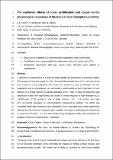The combined effects of ocean acidification and copper on the physiological responses of the tropical coral Stylophora pistillata
Abstract
A decrease in ocean pH of 0.3 units will likely double the proportion of dissolved copper (Cu) present as the free metal ion, Cu2+, the most bioavailable form of Cu, and one of the most common marine pollutants. We assess the impact of ocean acidification and Cu, separately and in combination, on calcification, photosynthesis and respiration of sub-colonies of a single tropical Stylophora pistillata colony. After 15 days of treatment, total calcification rates were significantly decreased in corals exposed to high seawater pCO2 (~1000-µatm, 2100 scenario) and at both ambient (1.6 - 1.9 nmols) and high (2.5 - 3.6 nmols) dissolved Cu concentrations compared to controls. The effect was increased when both stressors were combined. Coral respiration rates were significantly reduced by the combined stressors after 2 weeks of exposure, indicating the importance of experiment duration. It is therefore likely rising atmospheric CO2 will exacerbate the negative effects of Cu pollution to S. pistillata.
Citation
Cryer , S , Schlosser , C & Allison , N 2022 , ' The combined effects of ocean acidification and copper on the physiological responses of the tropical coral Stylophora pistillata ' , Marine Environmental Research , vol. 176 , 105610 . https://doi.org/10.1016/j.marenvres.2022.105610
Publication
Marine Environmental Research
Status
Peer reviewed
ISSN
0141-1136Type
Journal article
Description
We thank the Marine Alliance for Science and Technology for Scotland who contributed to the purchase of equipment used in this study (Award SG367).Collections
Items in the St Andrews Research Repository are protected by copyright, with all rights reserved, unless otherwise indicated.

